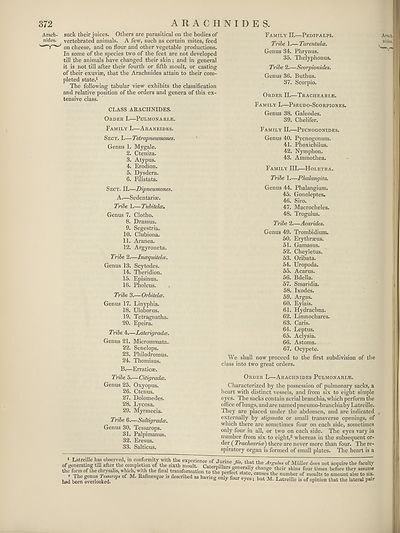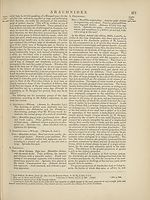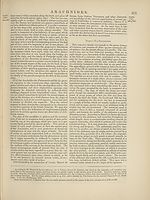Encyclopaedia Britannica > Volume 3, Anatomy-Astronomy
(380) Page 372
Download files
Complete book:
Individual page:
Thumbnail gallery: Grid view | List view

372
A R A C II N I D E S.
Arach- suck their juices. Others are parasitical on the bodies of
nides. vertebrated animals. A few, such as certain mites, feed
on cheese, and on flour and other vegetable productions.
In some of the species two of the feet are not developed
till the animals have changed their skin; and in general
it is not till after their fourth or fifth moult, or casting
of their exuviae, that the Arachnides attain to their com¬
pleted state.1
The following tabular view exhibits the classification
and relative position of the orders and genera of this ex¬
tensive class.
CLASS ARACHNIDES.
Order I.—Pulmonari^e.
Family II.—Pedipalpi.
Tribe 1.— Tarentulce.
Genus 34. Phrynus.
35. Thelyphonus.
Tribe 2.—Scorpionides.
Genus 36. Buthus.
37. Scorpio.
Order II.—Tracheari^e.
Family I.—Pseudo-Scorpiones.
Genus 38. Galeodes.
39. Chelifer.
Family I.—Araneides.
Sect. I.— Tetropneumones.
Genus 1. Mygale.
2. Cteniza.
3. Atypus.
4. Erodion.
5. Dysdera.
6. Filistata.
Family II.—Pycnogonides.
Genus 40. Pycnogonum.
41. Phoxichilus.
42. Nymphon.
43. Ammothea.
Family III.—Holetra.
Tribe 1.—Phalangita.
Sect. II.—Dipneumones*
A.—Sedentariae.
Tribe 1.— Tubitelce*
Genus 7. Clotho.
8. Drassus.
9. Segestria.
10. Clubiona.
11. Aranea.
12. Argyroneta.
Tribe 2.—Incequiteloe.
Genus 13. Scytodes.
14. Theridion.
15. Episinus.
16. Pholcus.
Tribe 3.— Orbitelce-
Genus 17. Linyphia.
18. Uloborus.
19. Tetragnatha.
20. Epeira.
Tribe 4.—Laterigradce.
Genus 21. Micrommata.
22. Senelops.
23. Philodromus.
24. Thomisus.
B.—Erraticae.
Genus 44. Phalangium.
45. Gonoleptes.
46. Siro.
47. Macrocheles.
48. Trogulus.
Tribe 2.—Acarides.
Genus 49. Trombidium.
50. Erythraeus.
51. Gamasus.
52. Cheyletus.
53. Oribata.
54. Uropoda.
55. Acarus.
56. Bdella.
57. Smaridia.
58. Ixodes.
59. Argas.
60. Eylais.
61. Hydrachna.
62. Limnochares.
63. Caris.
64. Leptus.
65. Aclysia.
66. Astoma.
67. Ocypete.
We shall now proceed to the first subdivision of tbe
class into two great orders.
Tribe 5.—Citigradce.
Genus 25. Oxyopus.
26. Ctenus.
27. Dolomedes.
28. Lycosa.
29. Myrmecia.
Tribe 6.—Saltigradce.
Genus 30. Tessarops.
31. Palpimanus.
32. Eresus.
33. Salticus.
Order I.—Arachnides PulmonarijE.
Characterized by the possession of pulmonary sacks, a
heart with distinct vessels, and from six to eight simple
eyes. The sacks contain aerial branchia, which perform the
office of lungs, and are named pneumo-branchiabyLatreille.
They are placed under the abdomen, and are indicated
externally by stigmata or small transverse openings, of
which there are sometimes four on each side, sometimes
only four in all, or two on each side. The eyes vary in
number from six to eight,2 whereas in the subsequent or¬
der ( Trachearice) there are never more than four. The re¬
spiratory organ is formed of small plates. The heart is a
/ Latrfle ^ observed, in conformity with the experience of Jurine fils, that the Argulns of Muller does not acquire the faculty
of generating till after the completion of the sixth moult. Caternillars wnernllv .u - , ' £ ’ »uc acquire me iai,uiL?
the form of the chrysalis, which, with the final transformation to the^ ?mS ^ u*? bef°re ?? T
■ The genus IWe/, of M. Refines,ue is described as havi„“„5y lut M 1 ""mf,er.of “““T', f fS
had been overlooked. ^ Iour eyes; but M. Latreille is of opinion that the lateral pair
Arach
nides
A R A C II N I D E S.
Arach- suck their juices. Others are parasitical on the bodies of
nides. vertebrated animals. A few, such as certain mites, feed
on cheese, and on flour and other vegetable productions.
In some of the species two of the feet are not developed
till the animals have changed their skin; and in general
it is not till after their fourth or fifth moult, or casting
of their exuviae, that the Arachnides attain to their com¬
pleted state.1
The following tabular view exhibits the classification
and relative position of the orders and genera of this ex¬
tensive class.
CLASS ARACHNIDES.
Order I.—Pulmonari^e.
Family II.—Pedipalpi.
Tribe 1.— Tarentulce.
Genus 34. Phrynus.
35. Thelyphonus.
Tribe 2.—Scorpionides.
Genus 36. Buthus.
37. Scorpio.
Order II.—Tracheari^e.
Family I.—Pseudo-Scorpiones.
Genus 38. Galeodes.
39. Chelifer.
Family I.—Araneides.
Sect. I.— Tetropneumones.
Genus 1. Mygale.
2. Cteniza.
3. Atypus.
4. Erodion.
5. Dysdera.
6. Filistata.
Family II.—Pycnogonides.
Genus 40. Pycnogonum.
41. Phoxichilus.
42. Nymphon.
43. Ammothea.
Family III.—Holetra.
Tribe 1.—Phalangita.
Sect. II.—Dipneumones*
A.—Sedentariae.
Tribe 1.— Tubitelce*
Genus 7. Clotho.
8. Drassus.
9. Segestria.
10. Clubiona.
11. Aranea.
12. Argyroneta.
Tribe 2.—Incequiteloe.
Genus 13. Scytodes.
14. Theridion.
15. Episinus.
16. Pholcus.
Tribe 3.— Orbitelce-
Genus 17. Linyphia.
18. Uloborus.
19. Tetragnatha.
20. Epeira.
Tribe 4.—Laterigradce.
Genus 21. Micrommata.
22. Senelops.
23. Philodromus.
24. Thomisus.
B.—Erraticae.
Genus 44. Phalangium.
45. Gonoleptes.
46. Siro.
47. Macrocheles.
48. Trogulus.
Tribe 2.—Acarides.
Genus 49. Trombidium.
50. Erythraeus.
51. Gamasus.
52. Cheyletus.
53. Oribata.
54. Uropoda.
55. Acarus.
56. Bdella.
57. Smaridia.
58. Ixodes.
59. Argas.
60. Eylais.
61. Hydrachna.
62. Limnochares.
63. Caris.
64. Leptus.
65. Aclysia.
66. Astoma.
67. Ocypete.
We shall now proceed to the first subdivision of tbe
class into two great orders.
Tribe 5.—Citigradce.
Genus 25. Oxyopus.
26. Ctenus.
27. Dolomedes.
28. Lycosa.
29. Myrmecia.
Tribe 6.—Saltigradce.
Genus 30. Tessarops.
31. Palpimanus.
32. Eresus.
33. Salticus.
Order I.—Arachnides PulmonarijE.
Characterized by the possession of pulmonary sacks, a
heart with distinct vessels, and from six to eight simple
eyes. The sacks contain aerial branchia, which perform the
office of lungs, and are named pneumo-branchiabyLatreille.
They are placed under the abdomen, and are indicated
externally by stigmata or small transverse openings, of
which there are sometimes four on each side, sometimes
only four in all, or two on each side. The eyes vary in
number from six to eight,2 whereas in the subsequent or¬
der ( Trachearice) there are never more than four. The re¬
spiratory organ is formed of small plates. The heart is a
/ Latrfle ^ observed, in conformity with the experience of Jurine fils, that the Argulns of Muller does not acquire the faculty
of generating till after the completion of the sixth moult. Caternillars wnernllv .u - , ' £ ’ »uc acquire me iai,uiL?
the form of the chrysalis, which, with the final transformation to the^ ?mS ^ u*? bef°re ?? T
■ The genus IWe/, of M. Refines,ue is described as havi„“„5y lut M 1 ""mf,er.of “““T', f fS
had been overlooked. ^ Iour eyes; but M. Latreille is of opinion that the lateral pair
Arach
nides
Set display mode to:
![]() Universal Viewer |
Universal Viewer | ![]() Mirador |
Large image | Transcription
Mirador |
Large image | Transcription
Images and transcriptions on this page, including medium image downloads, may be used under the Creative Commons Attribution 4.0 International Licence unless otherwise stated. ![]()
| Encyclopaedia Britannica > Encyclopaedia Britannica > Volume 3, Anatomy-Astronomy > (380) Page 372 |
|---|
| Permanent URL | https://digital.nls.uk/193762288 |
|---|
| Attribution and copyright: |
|
|---|---|
| Shelfmark | EB.16 |
|---|---|
| Description | Ten editions of 'Encyclopaedia Britannica', issued from 1768-1903, in 231 volumes. Originally issued in 100 weekly parts (3 volumes) between 1768 and 1771 by publishers: Colin Macfarquhar and Andrew Bell (Edinburgh); editor: William Smellie: engraver: Andrew Bell. Expanded editions in the 19th century featured more volumes and contributions from leading experts in their fields. Managed and published in Edinburgh up to the 9th edition (25 volumes, from 1875-1889); the 10th edition (1902-1903) re-issued the 9th edition, with 11 supplementary volumes. |
|---|---|
| Additional NLS resources: |
|

